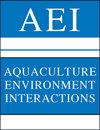What is the limit of sustained swimming in Atlantic salmon post smolts?
IF 2.5
2区 农林科学
Q2 FISHERIES
引用次数: 7
Abstract
A trend in Atlantic salmon aquaculture is to establish new production sites that are susceptible to extreme weather conditions; however, strong and persistent water currents may compromise fish welfare. Defining acceptable current conditions necessitates an assessment of sustained swimming abilities that are fuelled solely by aerobic metabolism and do not result in fatigue. In this study, the limit of sustained swimming was quantified with regards to both speed and time in Atlantic salmon of ~700 g and ~39 cm at 12°C by testing fish in groups of 10 in a large swim tunnel respirometer. First, critical swimming speed (Ucrit) (107 cm s−1) and minimum cost of transport (66 cm s−1) were measured. Sustained swimming trials at constant speeds were then performed based on a percentage of the group mean Ucrit (80, 85, 90, 95, 100 or 105%). Fish were forced to swim until they fatigued or until 72 h had passed. Surprisingly, most fish were able to sustain 80 and 85% Ucrit for 72 consecutive hours. However, at the highest speeds, fatigue was reached within the first 2 h. By categorizing fatigue times of individual fish into <2, 2−72 or >72 h, significant differences in relative swimming speeds were found that corresponded to 2.7, 2.5 and 2.2 body lengths s−1, respectively. These results document impressive sustained swimming capacities in farmed Atlantic salmon and add important temporal insights about ambient current limits with regards to fish welfare at exposed aquaculture sites.在大西洋鲑鱼幼崽中持续游泳的极限是多少?
大西洋鲑鱼水产养殖的一个趋势是建立易受极端天气条件影响的新生产地;然而,强烈和持续的水流可能会损害鱼类的福利。定义可接受的当前条件需要评估仅由有氧代谢提供能量且不会导致疲劳的持续游泳能力。在这项研究中,通过在大型游泳隧道呼吸计中以10条鱼为一组进行测试,对~700 g和~39 cm的大西洋鲑鱼在12°C下持续游泳的速度和时间进行了量化。首先,测量临界游泳速度(Ucrit) (107 cm s - 1)和最小运输成本(66 cm s - 1)。然后根据组平均Ucrit的百分比(80、85、90、95、100或105%)进行恒定速度的持续游泳试验。鱼被迫游到疲劳或72小时过去。令人惊讶的是,大多数鱼能够连续72小时维持80%到85%的温度。然而,在最高速度下,在前2小时内就会达到疲劳。通过将个体鱼的疲劳时间划分为72小时,发现相对游泳速度分别对应2.7、2.5和2.2体长s−1。这些结果记录了养殖大西洋鲑鱼令人印象深刻的持续游泳能力,并对暴露的水产养殖场的鱼类福利的环境电流限制提供了重要的时间见解。
本文章由计算机程序翻译,如有差异,请以英文原文为准。
求助全文
约1分钟内获得全文
求助全文
来源期刊

Aquaculture Environment Interactions
FISHERIES-MARINE & FRESHWATER BIOLOGY
CiteScore
4.90
自引率
13.60%
发文量
15
审稿时长
>12 weeks
期刊介绍:
AEI presents rigorously refereed and carefully selected Research Articles, Reviews and Notes, as well as Comments/Reply Comments (for details see MEPS 228:1), Theme Sections and Opinion Pieces. For details consult the Guidelines for Authors. Papers may be concerned with interactions between aquaculture and the environment from local to ecosystem scales, at all levels of organisation and investigation. Areas covered include:
-Pollution and nutrient inputs; bio-accumulation and impacts of chemical compounds used in aquaculture.
-Effects on benthic and pelagic assemblages or processes that are related to aquaculture activities.
-Interactions of wild fauna (invertebrates, fishes, birds, mammals) with aquaculture activities; genetic impacts on wild populations.
-Parasite and pathogen interactions between farmed and wild stocks.
-Comparisons of the environmental effects of traditional and organic aquaculture.
-Introductions of alien species; escape and intentional releases (seeding) of cultured organisms into the wild.
-Effects of capture-based aquaculture (ranching).
-Interactions of aquaculture installations with biofouling organisms and consequences of biofouling control measures.
-Integrated multi-trophic aquaculture; comparisons of re-circulation and ‘open’ systems.
-Effects of climate change and environmental variability on aquaculture activities.
-Modelling of aquaculture–environment interactions; assessment of carrying capacity.
-Interactions between aquaculture and other industries (e.g. tourism, fisheries, transport).
-Policy and practice of aquaculture regulation directed towards environmental management; site selection, spatial planning, Integrated Coastal Zone Management, and eco-ethics.
 求助内容:
求助内容: 应助结果提醒方式:
应助结果提醒方式:


